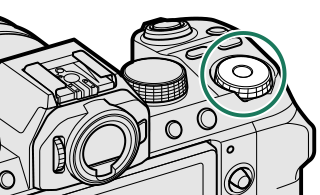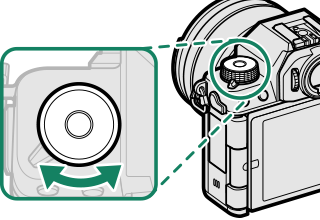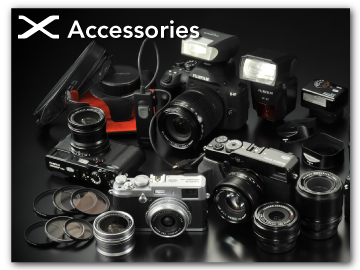Choosing a Shooting Mode
Choose a shooting mode according to the scene or type of subject.
- Y ([AUTO])
- Program AE ([P])
- Shutter-Priority AE ([S])
- Aperture-Priority AE ([A])
- Manual Exposure ([M])
- [SP] [SCENE POSITION ]
- [FILTER]
- Custom Modes
- The Command and Function Dials
Y ([AUTO])
When the mode dial is rotated to [AUTO], the camera automatically optimizes settings to suit the scene.
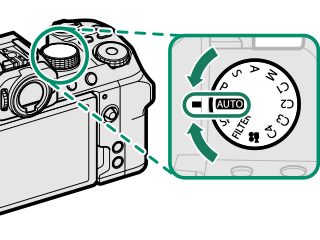
![]()
The display shows the icon for the mode most closely matching the type of scene detected by the camera.

C:[LANDSCAPE]
d:[NIGHT]
h:[NIGHT (TRIPOD)]
e:[MACRO]
Q:[SUNSET]
x:[SKY]
y:[GREENERY]
h:[PORTRAIT]
g:[BACKLIT PORTRAIT]
c:[MOVING OBJECT]
a:[PORTRAIT&MOTION]
b:[BACKLIT PORTRAIT&MOTION]
The mode selected may vary with shooting conditions. If the mode and subject do not match, select mode [P] or choose [SP] and select a scene manually.
The additional processing time required in some scene modes may increase save times.
No icon will be displayed if the camera is unable to determine the type of scene.
Program AE ([P])
Let the camera choose shutter speed and aperture for optimal exposure. Other values that produce the same exposure can be selected with program shift.
Rotate the mode dial to [P].
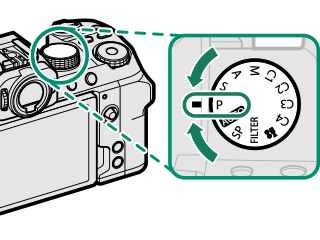
![]()
[P] will appear in the display.
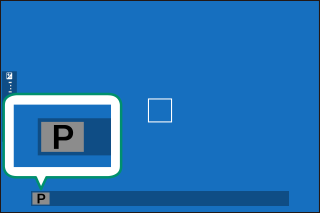
Program Shift
Rotate the front command dial to choose the desired combination of shutter speed and aperture (program shift).
Shutter speed
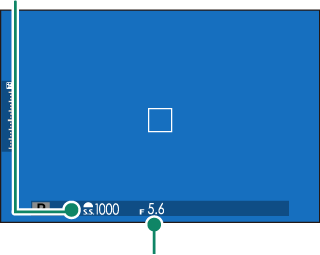
Aperture
Program shift is not available in any of the following circumstances:
- With flash units that support TTL auto
- When a flash mode other than D is selected for F [FLASH SETTING] > [FLASH FUNCTION SETTING]
- When an auto option is selected for H[IMAGE QUALITY SETTING] > [DYNAMIC RANGE]
- In movie mode
To cancel program shift, turn the camera off.
Shutter-Priority AE ([S])
Choose a shutter speed and let the camera adjust aperture for optimal exposure.
-
Rotate the mode dial to [S].
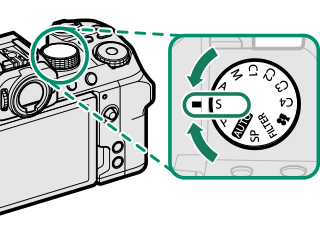

[S] will appear in the display.

-
Use the front command dial to choose a shutter speed.
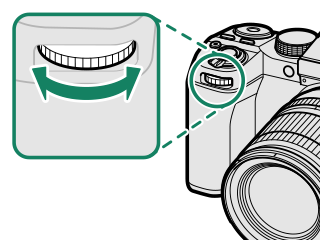
If the correct exposure cannot be achieved at the selected shutter speed, aperture will be displayed in red.
If the subject is outside the metering range of the camera, the aperture display will show “– – –”.
Time ([T])
Shutter speeds of 1 s or slower are referred to as “long time-exposures”. Use of a tripod is recommended to prevent the camera moving during the exposure.
A count-down timer will be displayed while the exposure is in progress.
To reduce “noise” (mottling) in long time-exposures, select [ON] for H[IMAGE QUALITY SETTING] > [LONG EXPOSURE NR]. Note that this may increase the time needed to record images after shooting.
Using a Remote Release
A remote release can be used for long time-exposures. When using an optional RR‑100 remote release or an electronic release from third-party suppliers, connect it to the camera's microphone/remote release connector via a third-party φ2.5 mm to 3.5 mm adapter.
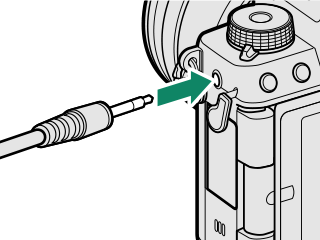
A confirmation dialog will be displayed when a remote release is connected; press [MENU/OK] and select n[REMOTE] for [MIC/REMOTE RELEASE].
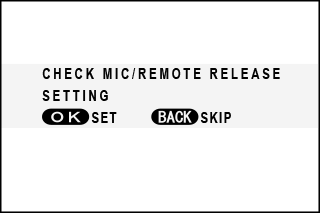
Aperture-Priority AE ([A])
Choose an aperture and let the camera adjust shutter speed for optimal exposure.
-
Rotate the mode dial to [A].
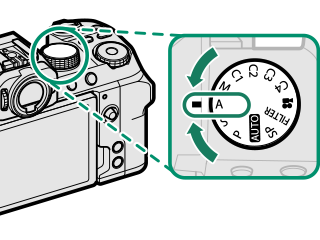

[A] will appear in the display.
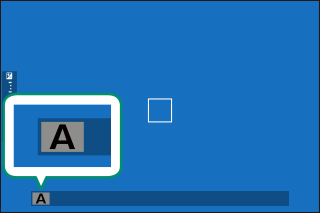
-
Use the front command dial to choose an aperture.

If the correct exposure cannot be achieved at the selected aperture, shutter speed will be displayed in red.
If the subject is outside the metering range of the camera, the shutter speed display will show “– – –”.
If the lens is equipped with a aperture ring, aperture can be adjusted by rotating the ring.
Previewing Depth of Field
When [PREVIEW DEPTH OF FIELD] is assigned to a function button, pressing the button displays a L icon and stops aperture down to the selected setting, allowing depth of field to be previewed in the display (aFunction Controls).
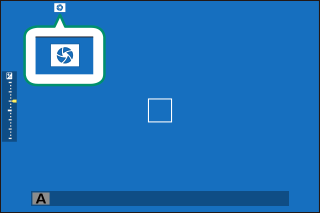
Manual Exposure ([M])
Alter exposure from that selected by the camera.
-
Rotate the mode dial to [M].
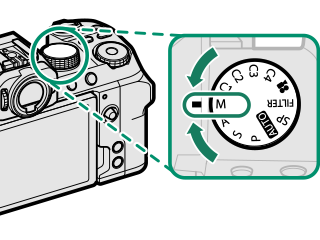

[M] will appear in the display.
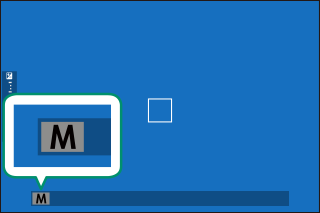
-
Rotate the rear command dial to choose a shutter speed and the front command dial to choose the aperture.
The manual exposure display includes an exposure indicator that shows the amount the picture would be under- or over-exposed at current settings.
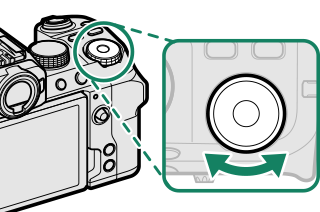
Shutter speed

Aperture
If the lens is equipped with a aperture ring, aperture can be adjusted by rotating the ring.
Bulb (B)
Choose a shutter speed of [BULB] for long time-exposures in which you open and close the shutter manually. Use of a tripod is recommended to prevent the camera moving during the exposure.
-
Using the rear command dial, choose a shutter speed of [BULB].

-
Press the shutter button all the way down. The shutter will remain open for up to 60 minutes while the shutter button is pressed; the display shows the time elapsed since the exposure started.
To reduce “noise” (mottling) in long time-exposures, select [ON] for H [IMAGE QUALITY SETTING] > [LONG EXPOSURE NR]. Note that this may increase the time needed to record images after shooting.
Exposure Preview
To preview exposure in the LCD monitor, select [PREVIEW EXP./WB] for D [SCREEN SET-UP] > [PREVIEW EXP./WB IN MANUAL MODE].
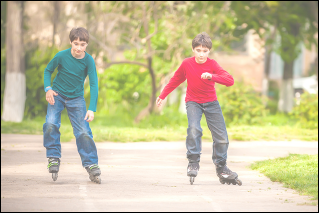

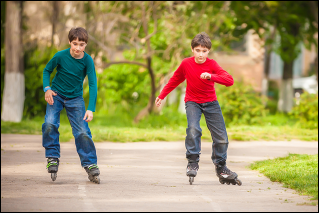
Select an option other than [PREVIEW EXP./WB] when using the flash or on other occasions on which exposure may change when the picture is taken.
[SP] [SCENE POSITION]
The camera offers a choice of “scenes”, each adapted to particular shooting conditions or a specific type of subject.
-
Rotate the mode dial to [SP] ([SCENE POSITION]).

-
Choose a scene via A [SHOOTING SETTING] > [SCENE POSITION].
Choose from the following options:
Scene Description h[PORTRAIT] Choose for portraits. Z[PORTRAIT ENHANCER] Processes portraits to give the subject a smooth, natural-looking complexion. M[LANDSCAPE] Choose for daylight shots of buildings and landscapes. N[SPORT] Choose when photographing moving subjects. O[NIGHT] Choose for poorly lit twilight or night scenes. H[NIGHT (TRIPOD)] Choose this mode for slow shutter speeds when shooting at night. p[FIREWORKS] Slow shutter speeds are used to capture the expanding burst of light from a firework. Q[SUNSET] Choose this mode to record the vivid colors in sunrises and sunsets. R[SNOW] Choose for crisp, clear shots that capture the brightness of scenes dominated by shining white snow. s[BEACH] Choose for crisp, clear shots that capture the brightness of sunlit beaches. f[UNDERWATER] Reduces the blue cast typically associated with underwater lighting. U[PARTY] Capture indoor background lighting under low-light conditions. V[FLOWER] Effective for taking more vivid shots of flowers. W[TEXT] Take clear pictures of text or drawings in print. The scene can also be selected in the shooting display via the front command dial.
[FILTER]
Take photos with filter effects.
-
Rotate the mode dial to [FILTER].
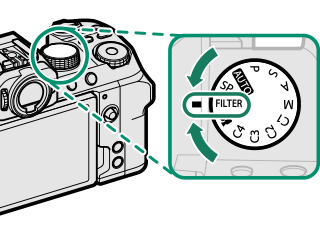
-
Choose a filter via A [SHOOTING SETTING] > [FILTER SETTING].
Filter Description G[TOY CAMERA] Choose for a retro toy camera effect. H[MINIATURE] The tops and bottoms of pictures are blurred for a diorama effect. I[POP COLOR] Create high-contrast images with saturated colors. J[HIGH-KEY] Create bright, low-contrast images. Z[LOW-KEY] Create uniformly dark tones with few areas of emphasized highlights. K[DYNAMIC TONE] Dynamic tone expression is used for a fantasy effect. X[SOFT FOCUS] Create a look that is evenly soft throughout the whole image. u[PARTIAL COLOR (RED)] Areas of the image that are the selected color are recorded in that color. All other areas of the image are recorded in black-and-white. v[PARTIAL COLOR (ORANGE)] w[PARTIAL COLOR (YELLOW)] x[PARTIAL COLOR (GREEN)] y[PARTIAL COLOR (BLUE)] z[PARTIAL COLOR (PURPLE)] Depending on the subject and camera settings, images may in some cases be grainy or vary in brightness or hue.
The scene can also be selected in the shooting display via the function dial.
Custom Modes
Rotate the mode dial to any of modes [C1] ([CUSTOM 1]) through [C4] ([CUSTOM 4]) to take pictures using previously-saved shooting menu settings. Settings can be saved or edited using H [IMAGE QUALITY SETTING] > [EDIT/SAVE CUSTOM SETTING].
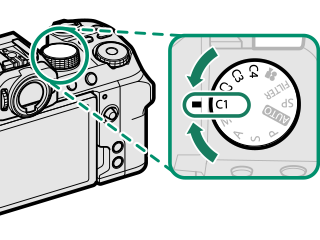
Saving Settings
-
Select H [IMAGE QUALITY SETTING] in the shooting menu, then highlight [EDIT/SAVE CUSTOM SETTING] and press [MENU/OK].
-
Highlight [EDIT/CHECK SETTING] and press [MENU/OK].
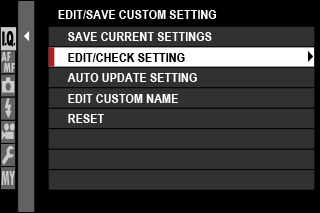
To store current camera settings in any of custom settings banks 1 through 4, select [SAVE CURRENT SETTINGS]. Previously-saved settings in the selected bank will be overwritten.
To restore default settings for selected banks, choose [RESET].
Banks can be renamed using [EDIT CUSTOM NAME].
If [ENABLE] is selected for [AUTO UPDATE SETTING], changes to settings in modes [C1] through [C4] will automatically be saved to the current bank.
-
Highlight a custom settings bank and press [MENU/OK] to select.
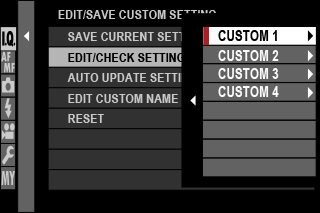
-
Highlight an item you wish to store in the custom settings bank and press [MENU/OK].
Adjust settings for the selected item.

-
Press [MENU/OK] to save changes to the selected item and return to the menu item list.
Adjust additional items as desired.
-
Pressing [DISP/BACK] in the menu item list displays a confirmation dialog. Highlight [OK] and press [MENU/OK] to save the settings to the selected bank.
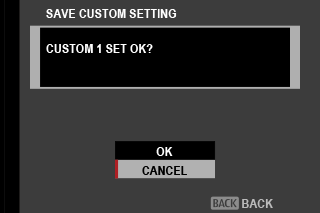
The Command and Function Dials
The roles of the command and Function dials vary with the mode.
| Front command dial | |
|---|---|
|
|
|
| AUTO (AUTO) |
Film simulation |
| P (PROGRAM AE) |
Program shift |
| S (SHUTTER PRIORITY AE) |
Shutter speed |
| A (APERTURE PRIORITY AE) |
Aperture |
| M (MANUAL) |
|
| SP (SCENE POSITION) |
Scene position |
| FILTER (FILTER) |
Program shift |
| C1/C2/C3/C4 (CUSTOM) |
Varies with exposure mode |
| F (MOVIE) |
|
| Rear command dial | |
|---|---|
|
|
|
| AUTO (AUTO) |
Exposure compensation |
| P (PROGRAM AE) |
|
| S (SHUTTER PRIORITY AE) |
|
| A (APERTURE PRIORITY AE) |
|
| M (MANUAL) |
Shutter speed |
| SP (SCENE POSITION) |
Exposure compensation |
| FILTER (FILTER) |
|
| C1/C2/C3/C4 (CUSTOM) |
Varies with exposure mode |
| F (MOVIE) |
|
| Fn Fn (function) dial |
|
|---|---|
|
|
|
| AUTO (AUTO) |
Film simulation |
| P (PROGRAM AE) |
|
| S (SHUTTER PRIORITY AE) |
|
| A (APERTURE PRIORITY AE) |
|
| M (MANUAL) |
|
| SP (SCENE POSITION) |
|
| FILTER (FILTER) |
Filter selection |
| C1/C2/C3/C4 (CUSTOM) |
Varies with exposure mode |
| F (MOVIE) |
|
The role performed by the function dial can be chosen using D [BUTTON/DIAL SETTING] > [FUNCTION (Fn) SETTING] (aThe Function Dial).

 .
.
